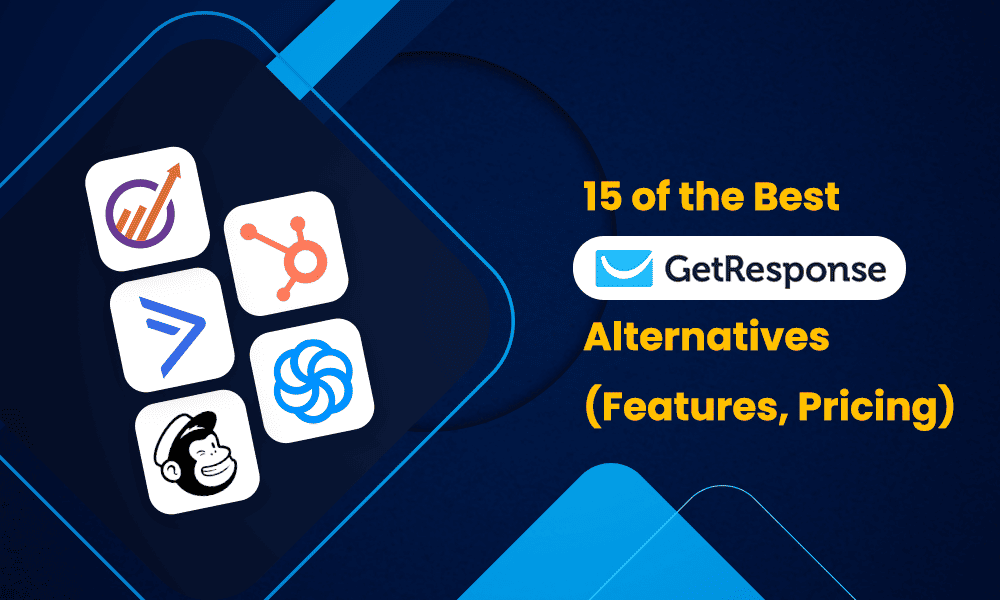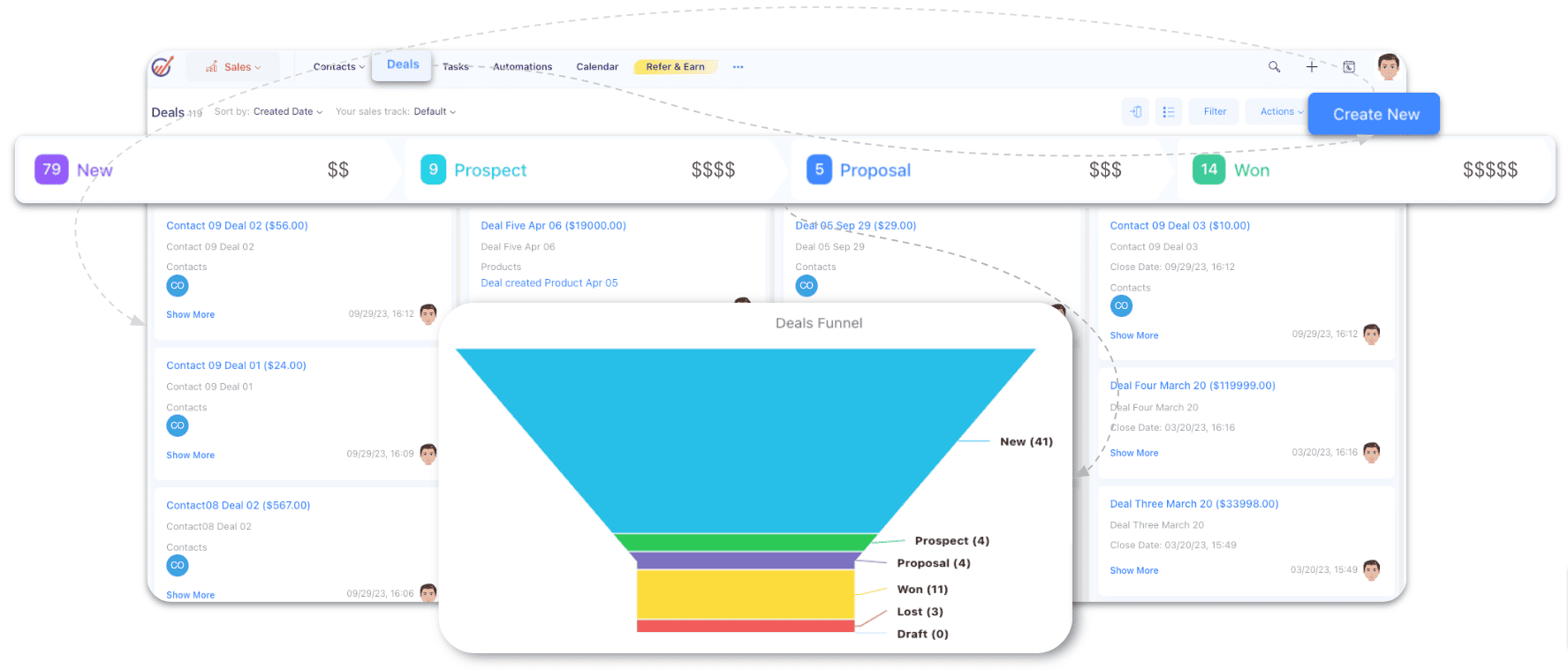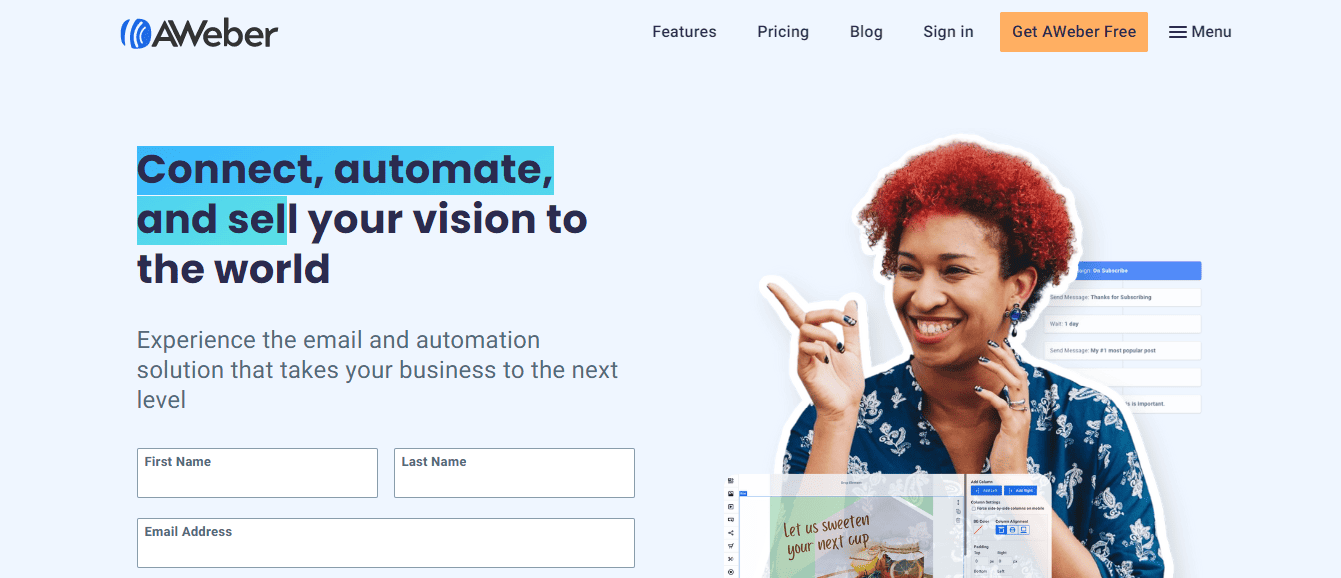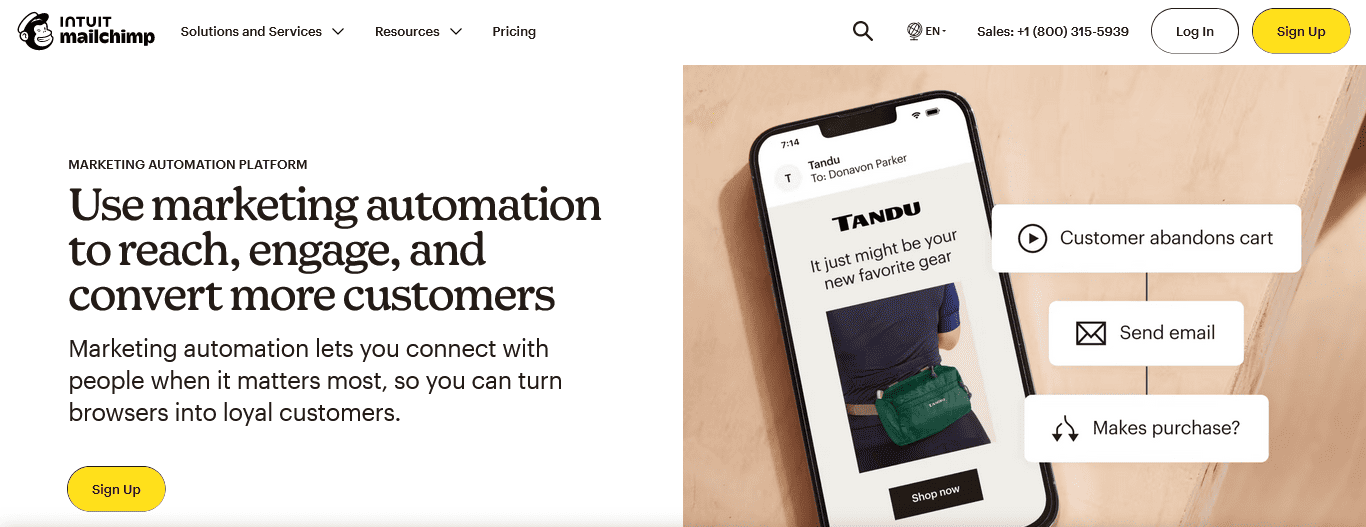Running successful email campaigns takes more than great content — it requires the right tools.
From ensuring high deliverability rates to offering advanced contact segmentation and intuitive design features, your email marketing platform plays a pivotal role in your success.
While GetResponse is a solid choice with advanced automation features, it’s not always the perfect fit for every business. For example, as your email contact list grows, GetResponse can become quite expensive, potentially straining your budget.
That’s why exploring GetResponse alternatives is crucial. In this blog, we’ve shortlisted 15 of the best GetResponse alternatives — breaking down their standout features, pricing, and unique advantages.
By the end, you’ll be equipped to pick the right email marketing solution for your business.
Table of Contents
15 Top GetResponse Alternatives That Can Do More
| GetResponse alternatives | Starting price | Free plan | Free trial | G2 rating |
| EngageBay | $12.99 per user paid monthly | Yes | 14 days | 4.75/5 |
| ActiveCampaign | $15 paid monthly (for 1,000 contacts) | No | 14 days | 4.5/5 |
| Kit (formerly ConvertKit) | $29 paid monthly (for 1,000 contacts) | Yes | 14 days | 4.4/5 |
| Brevo (formerly Sendinblue) | $29 paid monthly (for 1,000 contacts) | Yes | NA | 4.5/5 |
| AWeber | $25 paid monthly (for 1,000 contacts) | Yes | NA | 4.2/5 |
| Mailchimp | $13.50 paid monthly (for 500 contacts) | Yes | NA | 4.3/5 |
| Constant Contact | $30 paid monthly (for 1,000 contacts) | No | 30 days | 4.0/5 |
| Campaign Monitor | $44 paid monthly (for 1,000 contacts) | Yes | 30 days | 4.1/5 |
| Drip | $29 paid monthly (for 2,500 contacts) | No | 14 days | 4.4/5 |
| HubSpot | $20 paid monthly (1,000 contacts) | Yes | 14 days | 4.4/5 |
| Keap | $299 paid monthly (2,500 contacts) | No | 14 days | 4.2/5 |
| Ontraport | $89 paid monthly (1,000 contacts) | No | 14 days | 4.5/5 |
| MailerLite | $15 paid monthly (1,000 contacts) | Yes | 30 days | 4.6/5 |
| Omnisend | $20 paid monthly (1,000 contacts) | Yes | NA | 4.6/5 |
| Moosend | $16 paid monthly (1,000 contacts) | No | 30 days | 4.7/5 |
Let’s look at GetResponse alternatives in detail now.
1. EngageBay
Best affordable all-in-one marketing, sales, support CRM
- Ratings (as per G2): 4.75/5
- Starting price: $12.99 per user paid monthly
- Free trial length: 14 days
Why you should pick EngageBay
We might be slightly biased, but EngageBay is undoubtedly one of the top GetResponse alternatives for businesses wanting a feature-packed email marketing tool at an unbeatable price.
It offers extensive features, including a landing page builder, web forms, email broadcasts, email sequences, a reporting dashboard, and more.
EngageBay shines with its powerful video marketing templates, allowing you to create custom video thumbnails that grab attention. Embedding these thumbnails into emails is effortless, adding a dynamic touch to your campaigns.
Additionally, it offers over 1,000+ pre-designed, customizable email templates tailored to various industries and purposes, including order confirmations, apology emails, and introductory messages.
EngageBay is ideal for small businesses that want a robust platform to support their marketing and sales efforts without breaking the bank.
A quick take on EngageBay
Pricing: EngageBay includes a forever-free plan for up to 250 contacts and 1,000 branded emails. Paid plans start at just $12.99 per user per month and go up to $79.99 per user per month. Opting for annual billing offers an 8% discount.
Customer Support: All plans include email and live chat support. Paid plans also feature perks, such as free onboarding, a dedicated account manager, and phone support.
Integrations: Whether you’re looking to sync customer data, automate workflows, or enhance campaign tracking, EngageBay makes it seamless with one-click integration options. Popular tools like Zapier, Xero, and Integrately allow you to connect your favorite apps and create a smooth, unified marketing ecosystem.
| Pros | Cons |
|
|
2. ActiveCampaign
Best for advanced email automation needs

- Ratings (as per G2): 4.5/5
- Starting price: $15 paid monthly (for 1,000 contacts)
- Free trial length: 14 days
Why you should pick ActiveCampaign
ActiveCampaign offers a robust marketing automation suite alongside its email marketing tools. While it doesn’t include a free plan, it compensates by offering essential automation features in all its pricing plans — unlike GetResponse, which omits these features from its entry-level plan.
Additionally, ActiveCampaign provides access to deal pipelines and sales automation software as an optional add-on, further enhancing its functionality for businesses focused on streamlining their sales processes.
What sets ActiveCampaign apart is its high deliverability rate, a crucial factor in ensuring the success of your email campaigns and maximizing engagement.
A quick take on ActiveCampaign
Pricing: ActiveCampaign’s plans start at $15 per month for up to 1,000 contacts, offering features like email templates and up to five automation and triggers. The Enterprise plan is priced at $145 per month for 1,000 contacts. You can also enhance functionality with a CRM add-on for $95 per month, available with the Plus plan starting at $49 per month.
Customer support: ActiveCampaign offers robust support across all plans, including free onboarding, live chat, and ticket support. Users also benefit from active training sessions and a comprehensive knowledge base to ensure smooth implementation and effective use of the platform.
Integration: ActiveCampaign supports over 900 integrations, making it easy to connect with tools across eCommerce, CRM, social media, and more.
| Pros | Cons |
|
|
3. Kit (formerly ConvertKit)
Best for selling digital products

- Ratings (as per G2): 4.4/5
- Starting price: $29 paid monthly (for 1,000 contacts)
- Free trial length: 14 days
Why you should pick Kit
Kit is an email marketing automation platform designed specifically for creators such as musicians, authors, podcasters, and YouTubers. Whether you’re a solopreneur building your audience or managing a diverse audience with multiple product offerings, Kit is an excellent choice.
One standout feature is its unlimited email sends, allowing you to engage your audience without restrictions. As a GetResponse alternative, it excels in helping you monetize your digital products — automatically delivering items like eBooks or PDFs directly to your buyers’ inboxes.
Additionally, Kit enables you to set up automation and trigger email sequences, ensuring the right content reaches the right audience at the right time.
A quick take on Kit
Pricing: Kit offers three flexible plans to suit different needs. The Newsletters plan is free for up to 10,000 subscribers. The Pros plan starts at $25 per month, while the Pro Creator plan is $50 per month, both covering up to 1,000 contacts. Cost increases as the number of contacts grows, and annual billing saves you the cost of two months.
Customer support: Kit provides 24/7 customer support with all its plans, though priority support is available exclusively for Pro creators. Additionally, Kit offers helpful guides, tutorials, and a free migration service for creators with over 5,000 subscribers on paid plans.
Integrations: Kit offers seamless integrations with essential creator tools, including membership and course platforms, affiliate management, giveaways, and website builders. Plus, you can create custom integrations using their detailed API documentation.
| Pros | Cons |
|
|
4. Brevo (formerly Sendinblue)
Best for integrated SMS and email marketing
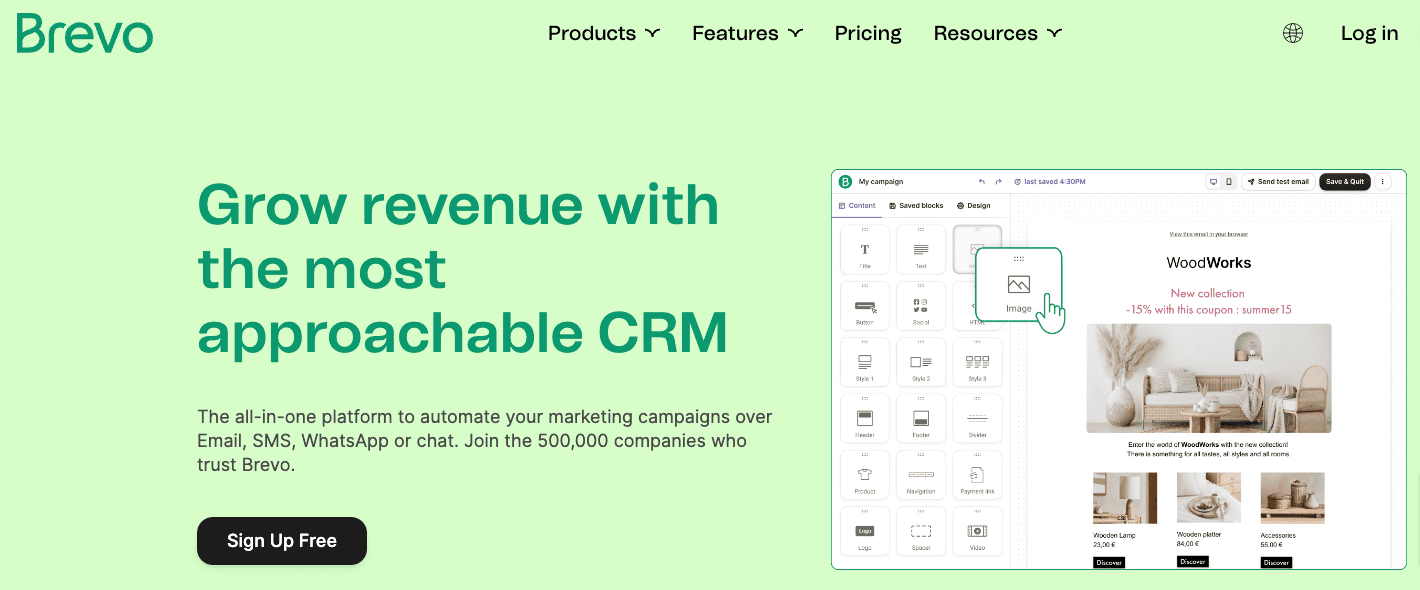
- Ratings (as per G2): 4.5/5
- Starting price: $29 paid monthly (for 1,000 contacts)
- Free trial length: NA
Why you should pick Brevo
Brevo (formerly Sendinblue) is a feature-rich platform with an intuitive interface, making it a strong alternative to GetResponse.
It’s an excellent choice if you’re looking to combine email and SMS marketing. With Brevo, you can send text-based promotional messages directly to customers, keeping them informed about events, offers, and products in real-time.
Additionally, Brevo allows you to create personalized content using dynamic emails and set up advanced segmented lists for targeted campaigns. While A/B testing isn’t available on the free or starter plans, it’s a valuable feature on higher tiers to help optimize your campaigns and improve performance.
A quick take on Brevo
Pricing: Brevo offers a forever-free plan that lets you send up to 300 emails daily. Its Starter plan begins at just $9 per month, with custom pricing available for the Enterprise plan. You can also purchase email credits, SMS, and WhatsApp campaigns as add-ons, with pricing based on the volume of messages or emails you need.
Customer support: Brevo provides 24/7 email support across all its plans, ensuring assistance is always available when you need it. Phone and chat support are included with the Business and Enterprise plans, while access to a dedicated account manager is reserved for Enterprise plan users.
Integration: Brevo offers seamless integrations with popular platforms like WordPress, Shopify, and PayPal, making it easy to connect your tools. You can also directly integrate Brevo with your website using their robust APIs for a customized experience.
| Pros | Cons |
|
|
5. AWeber
Best for sending bulk emails
- Ratings (as per G2): 4.2/5
- Starting price: $25 paid monthly (for 1,000 contacts)
- Free trial length: NA
Why you should pick AWeber
AWeber is a dedicated email marketing platform, particularly useful for creators looking to build their audience, run online courses or subscriptions, and sell products.
It enables you to run bulk email campaigns effortlessly — allowing you to send 10x of your subscribers monthly emails.
AWeber also provides tools like landing page builders, sales funnel automation, and the ability to sell products directly through your emails. Moreover, it lets you send AMP emails, a feature that’s missing in GetResponse.
A quick take on AWeber
Pricing: AWeber offers a free plan that allows up to 3,000 emails per month with a robust set of features. Paid plans start at $25/month (Lite) for up to 1,000 contacts and go up to $899/month (Unlimited) for creators with 100,000+ subscribers. Opting for annual billing can save you up to four months of fees.
Customer support: AWeber provides chat and email support across all plans, with phone support available on paid plans. Its top-tier plans include priority support and free migration services, ensuring a seamless onboarding experience. Additionally, AWeber offers detailed guides to help you get started with ease.
Integration: AWeber offers seamless integration with 100+ platforms like Facebook, Shopify, WordPress, WooCommerce, and PayPal. Best of all, these integrations are available across all plans, including the free one!
| Pros | Cons |
|
|
6. Mailchimp
Best for email personalization
- Ratings (as per G2): 4.3/5
- Starting price: $13.50 paid monthly (for 500 contacts)
- Free trial length: NA
Why you should pick Mailchimp
Mailchimp is an excellent email marketing platform for small to medium businesses, solopreneurs, and consultants. It’s best known for its advanced automation features, offering over 100 pre-built customer journeys to help you kickstart your campaigns with ease.
Additionally, Mailchimp provides behavioral triggers that enable you to send product-specific emails tailored to individual customers, boosting your chances of conversion.
What truly sets Mailchimp apart is its social media marketing tools, allowing you to target multiple channels and grow your audience. With its omni-channel dashboard, audience analytics, A/B testing, and more, Mailchimp empowers you to track and optimize your email marketing efforts effectively.
A quick take on Mailchimp
Pricing: Mailchimp offers a free plan that includes up to 1,000 emails per month for 500 contacts. Its paid plans — Essentials, Standard, and Premium — start at $9.04 per month (or $4.52 per month with annual billing). For businesses with occasional email needs, Mailchimp also provides a convenient pay-as-you-go option.
Customer support: Mailchimp provides comprehensive guides and tutorials to help users navigate its platform. Email support is available across all plans, with the free plan receiving 30 days of access. Personalized onboarding and live chat are reserved for paid plans, while phone support is exclusive to the premium plan.
Integration: Mailchimp offers seamless integration with over 300 apps across all its plans. You can connect your store, payment gateways, accounting tools, social media platforms, and more to streamline your workflows and enhance your marketing efforts.
| Pros | Cons |
|
|
7. Constant Contact
Best for handling event marketing
- Ratings (as per G2): 4.0/5
- Starting price: $30 paid monthly (for 1,000 contacts)
- Free trial length: 30 days
Why you should pick Constant Contact
Constant Contact is a versatile email marketing and social media management platform designed to help you ‘drive sales and get the results’ your business needs.
It also includes SMS marketing integration, though this feature is currently limited to U.S. audiences.
The platform is ideal for companies focused on event marketing, offering all the tools needed to create, promote, and manage events. It helps increase guest attendance while making it easier to build and maintain relationships with existing customers.
But it’s worth noting that Constant Contact can be on the pricier side, especially as your contact list grows.
In addition, Constant Contact can personalize and modify your email campaigns based on how your audience interacts with your emails and website pages, ensuring a tailored experience for your subscribers.
A quick take on Constant Contact
Pricing: Constant Contact’s pricing starts at $30 per month, with plans going up to $110 per month for up to 1,000 contacts. However, its entry-level Lite plan lacks key features like contact segmentation and detailed reporting, making it less ideal for businesses needing robust automation tools.
Customer support: Constant Contact provides award-winning customer support through phone and email with all its plans. They also offer a wealth of resources, including guides and an active community. For personalized assistance, you can even access 1:1 support with a marketing expert to help you get started.
Integration: Constant Contact supports over 300 integrations, making it easy to connect your favorite tools. Notably, it integrates with Canva for seamless email design and Vimeo for embedding impactful videos into your campaigns.
| Pros | Cons |
|
|
8. Campaign Monitor
Best for managing events and loyalty programs
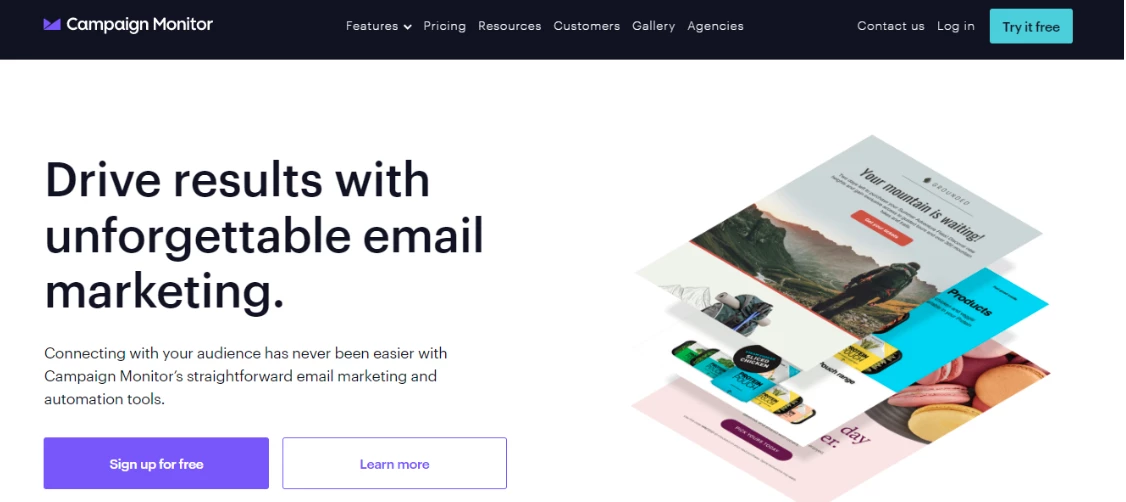
- Ratings (as per G2): 4.1/5
- Starting price: $44 paid monthly (for 1,000 contacts)
- Free trial length: 30 days
Why you should pick Campaign Monitor
Campaign Monitor, as a GetResponse alternative, is user-friendly and offers pre-built customer journeys for easy campaign management.
Beyond its basic email marketing tools, what truly sets it apart is its ability to manage tiered and punch card loyalty programs directly within Campaign Monitor — no third-party integrations required!
Additionally, you can integrate your event management system with Campaign Monitor to seamlessly promote your events.
While it may be on the pricier side compared to GetResponse, its extensive features make it a worthwhile investment depending on your business needs.
A quick take on Campaign Monitor
Pricing: Campaign Monitor offers a free plan for up to 500 contacts, valid for 30 days. After that, you can choose from three paid plans: Lite, Essentials, and Premier. The Lite plan starts at $44 per month for 1,000 contacts, with a limit of 12,500 monthly email sends, while still providing access to the most advanced features. The highest-tier Premier plan is priced at $169 per month and includes unlimited email sends.
Customer support: Campaign Monitor provides email support across all its plans, with phone support available only to those on the Premier plan. Additionally, it offers helpful resources such as training videos, deliverability support, and design and spam testing.
Integration: Campaign Monitor offers seamless integration with a wide range of tools, including billing platforms, surveys, CRMs, eCommerce solutions, and more, ensuring smooth, end-to-end business operations.
| Pros | Cons |
|
|
9. Drip
Best for promoting an online store
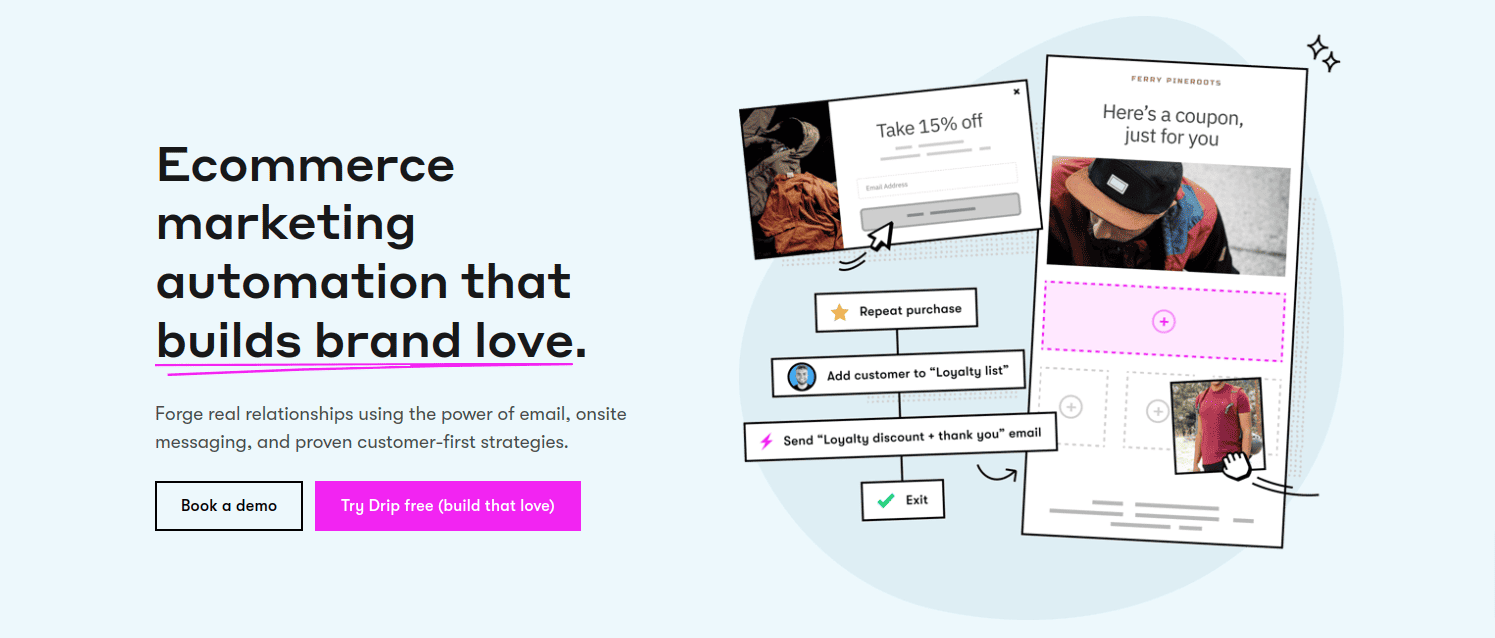
- Ratings (as per G2): 4.4/5
- Starting price: $29 paid monthly (for 2,500 contacts)
- Free trial length: 14 days
Why you should pick Drip
Drip is especially valuable for eCommerce businesses or any business with an online store. One of its standout features is simplicity — it offers all its features under a single plan, with pricing determined by the number of contacts.
It also boasts an impressive 99% delivery rate for on-brand emails. More importantly, Drip supports complex workflows and enables audience segmentation based on behavior and lifecycle stages.
What’s more, it helps you acquire customers on-site — beyond email — by providing full flexibility to design forms and embed them wherever you need.
A quick take on Drip
Pricing: Drip’s pricing is straightforward, based on your list size and email send volume, with no hidden fees. Plans start at $39 per month for up to 2,500 contacts and scale to $1,999 per month for 180,000 contacts. For larger lists, custom pricing options are available.
Customer support: Drip offers reliable customer support for its paying users, with email support available Monday through Friday from 9 AM to 5 PM CT. Customers subscribed to plans starting at $99 per month also benefit from live chat support during the same hours.
Integration: Drip offers over 100 integrations to enhance your functionality, with a strong focus on eCommerce. Shopify store owners, in particular, can unlock powerful tools to streamline their marketing efforts.
| Pros | Cons |
|
|
10. HubSpot
Best for full-fledged automation

- Ratings (as per G2): 4.4/5
- Starting price: $20 paid monthly (1,000 contacts)
- Free trial length: 14 days
Why you should pick HubSpot
HubSpot provides a free email marketing tool packed with essential features, including bulk email sending, a user-friendly drag-and-drop editor, and an extensive library of customizable templates.
Its goal-oriented templates cater to a variety of needs, such as email newsletters, birthday outreach, promotional offers, product launches, and re-engagement campaigns to nurture leads and grow your audience.
For more advanced features and scaling your marketing efforts, you need to opt for HubSpot’s paid plans — particularly suited for larger businesses.
A quick take on HubSpot
Pricing: HubSpot offers four pricing tiers, starting with the Starter plan at $20/month, ideal for small-scale email campaigns. The Professional plan at $890/month allows up to 10x your marketing contact tier email send limit per month, while the Enterprise plan at $3,600/month is tailored for larger businesses with advanced needs.
Customer support: HubSpot provides tiered customer support tailored to your plan, with email support available for Starter users and both email and phone support for Professional and Enterprise plans. Additionally, all users benefit from multilingual resources, an active HubSpot community, and a robust knowledge base to address their questions.
Integration: HubSpot integrates seamlessly with over 100 third-party tools, including Stripe, Facebook Messenger, and popular website platforms. Integration options vary by plan, allowing businesses to tailor their tech stack to their specific needs.
| Pros | Cons |
|
|
11. Keap
Best for combining sales team efforts

- Ratings (as per G2): 4.2/5
- Starting price: $299 paid monthly (2,500 contacts)
- Free trial length: 14 days
Why you should pick Keap
Keap provides a powerful email marketing solution bundled with marketing automation, sales automation, and a CRM database — all included at a single price. This comprehensive package also features tools like text messaging, landing pages, and appointment scheduling.
Keap automatically segments your contacts in its CRM based on industry, behavior, and personal details, enabling more precise targeting.
With curated email campaigns tailored to your leads’ interests, you can nurture relationships, save time using simple automation, and drive recurring revenue effortlessly.
A quick take on Keap
Pricing: Keap’s pricing is straightforward, with a single plan that scales based on the number of users and contacts. It starts at $299 per month for 1,500 contacts and 2 users, with all features included. Opting for annual billing offers a 17% discount.
Customer support: Every user benefits from US-based phone support, 24/7 chat assistance, a dedicated Customer Success Manager, and access to business automation education resources.
Integration: Keap makes integrations seamless with support for over 5,000 apps via Zapier, along with a range of specialized apps designed for effortless connectivity.
| Pros | Cons |
|
|
12. Ontraport
Best for UTM tracking

- Ratings (as per G2): 4.5/5
- Starting price: $89 paid monthly (1,000 contacts)
- Free trial length: 14 days
Why you should pick Ontraport
Ontraport is a robust GetResponse alternative that combines marketing and sales automation with powerful email marketing tools. It simplifies the process of launching campaigns with ready-to-use marketing funnels that can be set up in just minutes.
Ontraport also offers advanced features like UTM tracking to identify which emails drive sales, split testing to optimize performance, and comprehensive reporting to analyze your results.
Beyond email marketing, Ontraport enables you to create dynamic websites, apps, and landing pages without any coding skills, making it a versatile solution for businesses looking to scale their digital presence.
A quick take on Ontraport
Pricing: Ontraport offers four paid plans — Basic, Plus, Pro, and Enterprise — starting at $89/month and going up to $339/month. Annual billing lets you save the equivalent of two months’ fees.
Customer support: Ontraport offers exceptional customer support, available seven days a week via chat, email, or screen share. Their team is known for being responsive, complemented by a supportive community, step-by-step guides, templates, and instructional videos.
Integration: Ontraport offers seamless integrations with popular third-party applications, including Facebook Custom Audiences and WordPress, making it easy to connect your marketing efforts across platforms.
| Pros | Cons |
|
|
13. MailerLite
Best for running eCommerce and newsletters
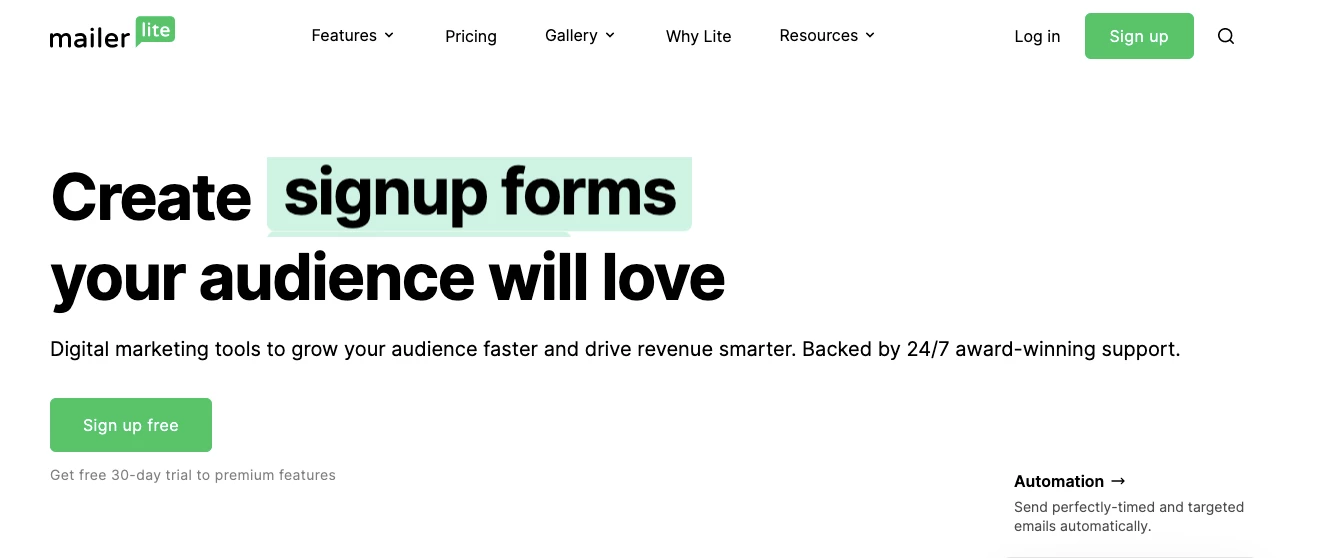
- Ratings (as per G2): 4.6/5
- Starting price: $15 paid monthly (1,000 contacts)
- Free trial length: 30 days
Why you should pick MailerLite
MailerLite offers a comprehensive suite of tools for both newsletter senders and eCommerce businesses to run successful email marketing campaigns.
For eCommerce, you can easily build, promote, and sell online all from one platform. Simply choose an eCommerce template, connect to Stripe, and use email marketing to start selling. With over 30 design blocks, you can create engaging product pages that convert.
For newsletter senders, MailerLite automates subscriber management, handling new sign-ups, cancellations, and changes seamlessly. It can personalize emails and send them automatically whenever someone subscribes or updates their preferences.
A quick take on MailerLite
Pricing: MailerLite offers a forever-free plan with up to 12,000 monthly email sends and access to a wide range of features. Its paid plans — Growing Business, Advanced, and Enterprise — start at $15 per month for 1,000 contacts, with custom pricing available for businesses with over 100K subscribers.
Customer support: MailerLite offers email and chat support for all users though it’s valid for only 30 days in its free plan. Paid plan subscribers get 24/7 priority support, and Enterprise customers enjoy additional benefits, including a dedicated success manager and personalized onboarding support.
Integration: Whether you need to sync data, automate tasks, or enhance your email marketing efforts, MailerLite supports over 150 integrations.
| Pros | Cons |
|
|
14. Omnisend
Best for omnichannel marketing efforts
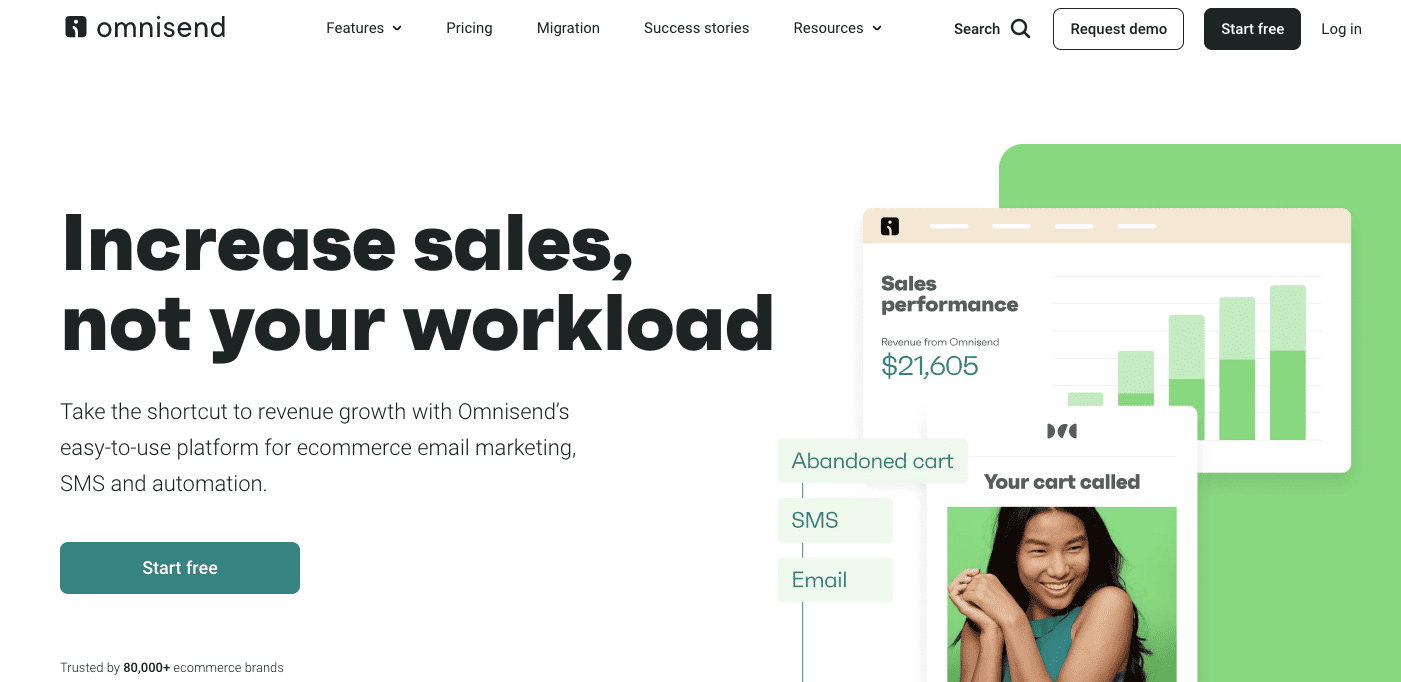
- Ratings (as per G2): 4.6/5
- Starting price: $20 paid monthly (1,000 contacts)
- Free trial length: NA
Why you should pick Omnisend
Omnisend is an excellent alternative to GetResponse, especially for businesses looking to execute seamless omnichannel marketing campaigns. It offers an integrated suite of email, SMS marketing, and web push notifications, enabling you to connect with customers across multiple touchpoints.
What’s more, Omnisend integrates your email and text campaigns with Shopify’s product review app. If you run a Shopify store, you can automatically request customer reviews via email or text after a purchase — boosting your credibility and driving more sales.
Trusted by over 125,000 eCommerce brands, Omnisend is a go-to choice for scaling your email marketing efforts effectively.
A quick take on Omnisend
Pricing: Omnisend offers a free plan for up to 250 contacts, giving you access to all its features. Paid plans start at $20 per month (Standard) and go up to $59 per month (Pro) for 1,000 contacts. The main difference between plans lies in the number of email, SMS, web push notifications, and product review credits included.
Customer support: Omnisend offers 24/7 live chat and email support across all plans, ensuring help is always available when you need it. Additionally, the Omnisend Academy provides valuable resources to help users master the platform.
Integration: Omnisend offers seamless data synchronization with over 130 integrations, including leading eCommerce platforms like Shopify.
| Pros | Cons |
|
|
15. Moosend
Best for pre-built automation triggers

-
- Ratings (as per G2): 4.7/5
- Starting price: $16 paid monthly (1,000 contacts)
- Free trial length: 30 days
Why you should pick Moosend
Moosend is a powerful alternative to GetResponse, offering all the essential features you need to effectively market your business. It provides a wide selection of customizable email templates that make designing and sending emails to your contact lists a breeze.
What sets Moosend apart is its ability to automate repetitive tasks and track website activity seamlessly. With its visual workflow builder, you can simplify complex processes, while the drag-and-drop landing page editor makes creating stunning, high-converting pages effortless.
A quick take on Moosend
Pricing: Moosend offers three paid plans — Pro, Moosend+, and Enterprise — starting at $16 per month for 1,000 contacts, with custom pricing available for higher tiers. For email campaigns, you can purchase an Email Credits Bundle, starting at $350 for 350,000 email credits and scaling to $1,000 for 1,000,000 email credits.
Customer support: Moosend offers a comprehensive knowledge base, email support, and live chat assistance across all its plans. Priority support and a dedicated account manager are exclusive to its Enterprise plan, while Moosend+ subscribers can opt for an account manager as an add-on.
Integration: Moosend offers over 100 integrations and API access across all its plans, making it easy to connect your favorite tools and customize your workflows effortlessly.
| Pros | Cons |
|
|
What To Look For in a GetResponse Alternative
When choosing an alternative to GetResponse, here are the key factors to consider:
Comprehensive functionality
Decide whether you need a standalone email marketing tool with advanced email-specific features or a broader platform that also supports business automation for marketing, sales, and customer service. Clarifying your needs will help you narrow down your options effectively.
Additionally, consider the platform’s library of email templates and pre-built workflow automation. These features can save significant time and effort when designing and managing your campaigns.
Email and contact limits
When evaluating a GetResponse alternative, it’s crucial to check the email sending limits and the size of your contact list across different plans.
Does the platform impose strict limits on the number of emails you can send, or does it offer unlimited email sends? These factors can significantly impact your campaigns as you scale.
Pricing
When evaluating pricing, consider both the structure and scalability of the tool. Some platforms charge based on the number of contacts or emails sent while still providing access to a full suite of features.
On the other hand, some tools may offer unlimited email sending but limit the number of available features on lower-tier plans.
Choosing a platform that fits your budget while offering the essential features you need for successful campaigns is important.
Ease of use and integration
Lastly, prioritize a user-friendly and intuitive interface, as it saves valuable time when designing and managing campaigns.
Additionally, seamless integration with tools like CRMs, eCommerce platforms, or Zapier ensures smooth workflows and better alignment with your existing tech stack, making your marketing efforts more efficient.
Is GetResponse the Best Email Marketing Platform for Your Business?

GetResponse is a powerful email marketing platform that provides a comprehensive suite of tools to help businesses create and automate content, boost sales, and drive website traffic. It offers features for event-based marketing and personalized campaigns across email, SMS, web, and mobile channels.
While GetResponse doesn’t offer a free plan, it provides a 30-day free trial for you to experience its features before committing to a purchase. This gives you a risk-free way to evaluate the platform.
Recently, GetResponse launched a new plan specifically for creators, starting at $69 per month, which includes 24/7 support.
In addition to this, GetResponse offers four paid plans designed for email automation, marketing automation, eCommerce marketing, and premium features with GetResponse Max. Pricing starts at $19 per month for up to 1,000 contacts, with plans going up to $1,099 per month, billed monthly.
GetResponse pros and cons
GetResponse offers a variety of powerful features, though it’s not without its drawbacks.
Pros
- GetResponse provides strong tools to create high-converting funnels and landing pages
- Offers advanced segmentation capabilities that let you create ultra-targeted marketing campaigns
Cons
- GetResponse’s forms aren’t very responsive, and the templates appear outdated compared to newer platforms.
- Many users have encountered difficulties while importing email lists, which can be frustrating for businesses with large contact databases.
Wrap Up
Finding the right email marketing tool doesn’t have to be tricky if you know what to look for.
All the GetResponse alternatives we’ve discussed offer robust solutions that can handle everything GetResponse does — and sometimes even more.
If you’re looking for a more comprehensive automation platform that goes beyond just email marketing and offers affordable pricing, EngageBay is a great choice.
It’s one of the most budget-friendly options on this list, especially when comparing higher-end plans.
Ready to make the switch? Reach out to us, and we’ll help you set up an account and a demo to get you started!
Frequently Asked Questions (FAQs)
1. Why should I consider switching from GetResponse to another email marketing platform?
Switching from GetResponse might be beneficial if you’re looking for more affordable pricing, enhanced features, or better integration options that suit your business needs.
2. What are the best alternatives to GetResponse?
Some of the best alternatives to GetResponse include EngageBay, ActiveCampaign, and Moosend, offering strong features, scalability, and competitive pricing.
3. Is GetResponse free to use?
GetResponse doesn’t offer a free plan, but it provides a 30-day free trial for you to explore its features before committing to a paid plan.
4. Which email marketing software is best suited for small businesses?
Email marketing tools such as EngageBay, MailerLite, and Kit are excellent options for small businesses due to their affordable pricing, comprehensive automation features, and ease of use.
5. Does EngageBay offer more affordable pricing than GetResponse?
Yes, EngageBay offers more affordable pricing, with plans that are less expensive than GetResponse, especially when considering higher-tier plans.
6. Which businesses benefit most from switching from GetResponse?
It ultimately depends on your business’s unique needs and whether GetResponse offers the best solutions for you. For example, if you may require higher email sending limits, advanced segmentation features, or a more affordable pricing option, you can benefit from GetResponse alternatives.
7. What are the most important features to consider when looking for GetResponse alternatives?
Some key features to prioritize when switching email marketing software include advanced segmentation, ease of use, integrations with other tools, and affordable pricing to get the most value from your alternative.
8. How does EngageBay’s customer support compare to other email marketing software?
EngageBay offers strong customer support with live chat, email assistance, and free onboarding sessions, making it an excellent choice for users seeking responsive help.
An older version of this post was authored by Abdul Bashid.
